Sister Dorothy Stang: Her Legacy Endures...Prophets for a New Era
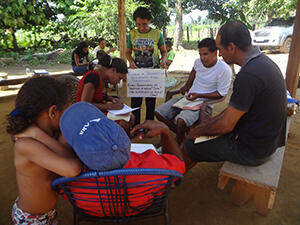 |
| Sister Maeia Vagner Souza Silva (center) teaches biblical studies in the São João Batista community in Anapu |
In the town of Anapu, Brazil, in the Wild West of the Amazon, a little girl said to the man handing out posters with an image of Sister Dorothy Stang, “I want one, too.”
“No,” the man told her. The priest had said only one poster to a family, and the man had already given a poster to the little girl’s mother.
“But I want one,” the girl said.
“No,” the man said.
“But Dorothy is my friend,” the little girl said. “And she wants me to have one!”
Sister Dorothy Stang was murdered 15 years ago. The little girl is six or seven. Such is Sister Dorothy’s presence, even today.
“Yes, Dorothy is alive and present,” says Sister Jane Dwyer, who worked alongside Sister Dorothy, and who along with Sister Kathryne “Katy” Webster remains in Anapu carrying on the work.
“In Belém and Altamira (the state capital and a small city to the west, respectively)," Sister Jane says, “everyone says Sister Dorothy had coffee at their house, or she took my taxi, or even that she had a beer there.”
And the Sisters, she says, now all of them are called ‘Dorothys.’ The same hold true for people who go into the forest to side with the subsistence farmer. They are ‘Dorothys’ as well.
“The poor, they’ve taken her on,” says Sister Jane. “She is their witness, their protector.”
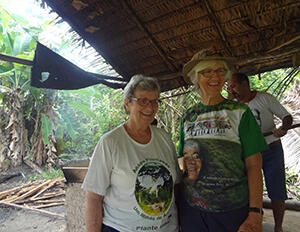 |
| Sister Jane Dwyer (lef) and Kathryne "Katy" Webster continue the mission and legacy of Sister Dorothy |
Sister Dorothy, a Dayton, Ohio native, began her work in Brazil in 1966 after 15 years as an elementary school teacher in Illinois and Arizona. In 1982, she moved to Anapu to participate in the government-sponsored sustainable development projects, which were an effort to resettle landless, often indigent, families from overcrowded urban areas to small, family farms in the Amazon. Many of these same families Dorothy already knew.
The homesteading efforts, however, and in short order, interfered with the illegitimate and often illegal claims to the land by loggers and ranchers, which set the stage for years of violent conflict, conflict responsible for Sister Dorothy’s assassination along a lonely stretch of road, and that continues today.
But Sister Dorothy’s legacy, in very concrete ways, lives on.
The small community schools she established, away from town and in the forest near the families of the farmers, continue, and with a strong agricultural curriculum.
The consciousness and activism on the part of the farmers regarding protection and replenishment of the natural environment remains rigorous, such that farmers are maintaining and replanting trees over up to 80 percent of their properties, and substituting forest-friendly crops such as cacao, black pepper and açai in place of corn.
And perhaps most importantly, Sister Dorothy’s organization of the farmers into a cohesive and powerful force, where once they were isolated and distrustful of one another, had only grown stronger, allowing them to hold onto their land through initiatives of their own and through organizations of their own creation, such as the Anapu Defense Committee.
“There is an atmosphere now of ‘we can do this,’” says Sister Katy, who arrived in Anapu in 1993. “it’s intangible but it’s an attitude of ‘we can do it.’”
GLOBAL LEGACY
Shortly before Sister Dorothy’s death, 23-year-old English university student Samuel Clements was in the south of Brazil working on his environmental sciences dissertation, but wanted to go north into the Amazon. Greenpeace – often in Brazil surrounded by barbed wire and with its employees wearing bullet-proof vests – put him in touch with Sister Dorothy. He called her on the phone, and only later opened a map to see how he could reach her. Two plane rides, a boat, a bus and motorbike ride later, he met her in Altamira. Accompanying him was a videographer he had invited from England to document Sister Dorothy’s work. Immediately upon arrival, the tenseness of the situation was palpable.
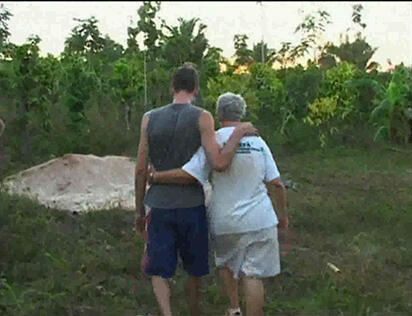 |
| Sister Dorothy inspired Samuel Clements to share her vision of the interconnectedness of life with others. |
“We had to keep in the shadows that first night,” Samuel says. “We had to keep the cameras down. I remember Sister Dorothy kind of hiding when certain men went by.”
Samuel and the videographer traveled with Dorothy to Anapu and also into the forest. They met and broke bread with families in the sustainable development communities. They filed, spoke with Sister Dorothy at length, and learned as much as they could. They saw firsthand, as Samuel says, “the persecution of the people, and the slaughter of the trees.”
Then, after three or four days, they left.
“it was very short,” Samuel says.
“She was worried about our safety.”
Several months later, before Samuel had even wrapped up the editing of The Student, the Nun and the Amazon, which would later become a defining documentary seen all over the world, Sister Dorothy was dead.
ON THE GROUND – NOW
“When they killed Dorothy, it had such repercussions,” says Sister Katy. “They (the large landholders) didn’t expect it. So they fell back, regrouped. They said, “How are we going to do this now’”
The election of Brazil’s current far-right president – Jair Bolsonaro – has in part provided an answer. President Bolsonaro has dismissed officials responsible for protection of the Amazon, and for the land rights of people who live there. He’s gutted the National Institute of Colonization and Agrarian Reform, an organization established to bring order to land reform, and has undermined – officially and unofficially – laws aimed at deforestation and reigning in illegal ranching, mining and logging, including in the Anapu area.
At the same time, murders and assassinations that had abruptly declined after the global publicity and condemnation surrounding Sister Dorothy’s death, are rebounding. A red cross, installed beside Sister Dorothy’s tomb, now bears the names of 19 farmers murdered.
“They [the landowners] have changed their tactics,” says Sister Katy. “They kill farmers away from their property. They kill them in town, or at festivals, or on the streets. They do it so it will be camouflaged, so it will be covered. But we know they did it. The people know they did it.”
“Dorothy was a mother figure,” says Sister Jane. “She was a leader in that moment because she had to be. The two of us [Sister Jane and Katy], we’re friends, companions and sisters. Our principal purpose here now is to be a voice to the outside world.”
KNOWING DOROTHY
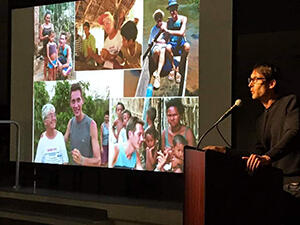 |
| In early February 2020, Samuel Clements spoke at the Mount Notre Dame convent in Cincinnati, Ohio and shared his reflections about Sister Dorothy and the environment. |
“Oh, I wish I could have known her, could have worked with her,” a priest in Anapu once said, and to which a woman responded, "Well, she left a lot of seeds here.”
And a lot of seeds all over the world, including in Vatican proclamations, U.S. Congressional resolutions, and a United Nations Human Rights award. But also, quietly in the hearts and minds of individuals.
“She’s there as the smile that greeted me,” says Samuel Clements, from England. “I recall that vividly. The softness of her voice, the strength of her voice, the strength of her beliefs. She saw the goodness of people, and could draw that out. It’s made me a fuller human being. I understand I can be kinder, wiser and more courageous.”
And from Dayton, Ohio, Sister Dorothy’s 16-year-old grandniece Madalyn (Maddy) Richardson, just an infant at the time of her great-aunt's death, has taken up the environmental mantle.
Beginning at age 5 or 6, she began learning from family members of her great-aunt's cause, of her spiritually and of her eventual martyrdom. Now, Maddy recycles, uses as little electricity as she can, and for her senior capstone project at Chaminade-julienne High School, will focus upon the environment.
“There’s only one planet and we have to protect it,” she says. “ [Sister Dorothy] changed world in such a short amount of time, but she did so much in that time that will last forever.”
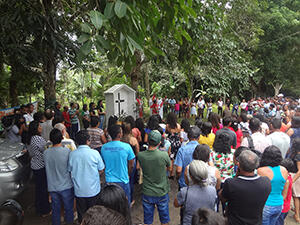 |
| People honor, imitate and pray to Sister Dorothy during the Forest Pilgrimage to her gravesite each July. |
As in Brazil, where the name Dorothy is not just a proper noun anymore, but is a name for anyone who goes into the forest to protect creation and to be one with the families who live there.
“We lived with Dorothy as a companion,” says Sister Katy.” But she isn’t the same woman now who we lived with. She is bigger than us, and we give her to the world.”
Sometimes, where Sister Dorothy is buried at the São Rafael Training Center, which she helped found and which is surrounded by forest and gardens and only accessible on foot, pilgrims will come. Some travel from long distances, and some on a regular basis. Often, on the road that runs not too far away, truckers will park their trucks. They will walk through the trees, cross the cable bridge, and pray before Dorothy’s tomb.
“Dorothy masked Brazil,” says Sister Jane. “She marked the world.”
